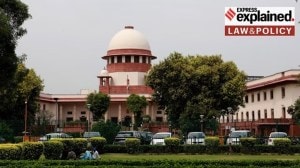Palanivel Thiaga Rajan interview: Power being taken from states to the Union, creating complexity
'Why should it be in the Union’s interest that you cannot prepay? On what logic does it make sense? what purpose is served by not allowing prepayment?'
 Palanivel Thiaga Rajan. PTI file
Palanivel Thiaga Rajan. PTI fileTAMIL NADU Finance Minister Palanivel Thiaga Rajan said the Centre has over the past seven years steadily increased its control over state government’s spending power which is leading to a lot of inefficiencies. Speaking to SUNNY VERMA, he said the increasing use of cesses and surcharge by the Centre is “a way of enfeebling the states, of tying their hands, dismantling their independence to spend money, and moving it into grants and schemes makes it much more controlled by them.” Edited excerpts:
On Centre-state fiscal relations
I’ll give you some history … The problem begins with a fundamental, anti-federal, anti-state, authoritarian approach of Delhi. It’s an old saying in politics that where you stand depends on where you sit, implying that where you stand on the issues based on whether you sit in Opposition, in the House or out on the street, etc. That saying cannot be more apt, there’s a classic example for that saying being true, which is our current Prime Minister (Narendra Modi). As a Chief Minister, he was the greatest champion of states’ rights, most vocal, even may be overshadowing Jayalalithaa (former Tamil Nadu Chief Minister) herself. Since he has become Prime Minister, it has gone 180 degrees. It is not possible to change any more dramatically than that. Complete, complete opposite, completely decimating states’ rights in every way: in money, management, micromanagement, centrally sponsored schemes, in every way. This is, by far, the most authoritarian power grab in the history of India.
Directly, directly, directly — it couldn’t be more directly — in contrast to every word he spoke for states’ rights when he was Chief Minister of Gujarat for 13 years. This is the underlying context. See, they do it bit by bit, bit by bit, insidious creeping. So, they started by ramping up the Centrally-sponsored schemes like crazy, up to Rs 4-6 lakh crore of direct benefits and Centrally-sponsored scheme transfers. They have this tendency to do publicity value, they are geniuses at marketing and very, very low moral character. That is to say, they will start one scheme, they will say subsidy for X. At first, they will give 70 per cent, the state will give 30 per cent, and they will put the Prime Minister’s picture and everything. Second year they will give 50 per cent and say state put 50 per cent. Third year they will give 20 per cent, states give 80 per cent. Fourth year, they say state has to continue but we will give zero, right. It will still be called ‘PM xyz scheme’. So this is a kind of my name but your money kind of game.
State subjects
The next point is in the actual administration of things like dams, ports, roads, state boundaries, education, health, exams, cooperatives — all of these are states’ subjects, 100 per cent state subjects, some of them concurrent list (of the Constitution) subjects. (They) bring an overarching legislation, ram it through Parliament with no debate, no committee, basically, take control of things that they have no business taking control of, which are completely antithetical to states’ rights. Now comes the really sad part. It is an undeniable tenet of democracy that the closer you are to the people, the more accountability is built into the system.
… So this is a fundamental tenet that if you have power and decision making allocated to the nearest point to the people, then you can get accountability and increase the likelihood of delivery of results. If you take it far away from the people, you inherently have a problem because then be very difficult to have any connectivity between the decision maker and the beneficiaries of the decision. So this is the sad part as they keep taking the power more and more away from states and local bodies to the Union; they are inherently creating problems of complexity in two or three ways. One, they are reducing accountability of government to the people. Without involving the states and local bodies, they simply cannot effectuate policy. They don’t have enough employees, they don’t have data, and they don’t have enough reach. If you empower yourself you can use it vindictively, you can use it negatively, you can cut off something – it’s like a rope, you can use it to choke, strangle or hold somebody, but you cannot push on a rope. You cannot create something by having a rope … Look at all the audit reports on Swachh Bharat, on krishi kalyan, they say the money goes, some toilets are built but there is no water supply. The water supply cannot be continuously monitored from Delhi, right, water supply is a municipal subject. It’s not even a state subject. So you build all this, but if there is no water supply, what happens is you’ve just wasted the money.
Centre’s creative accounting
In the context of all this I say that, therefore, they have taken two accounting tricks, what I called as exquisitely creative accounting. Because of Article 293 (3), the previous AIADMK government, which was a coalition partner of the BJP, never felt like taking it (the Centre’s loan) because, at that time, it was very clear that it was just bait, because the amounts were trivial, around Rs 300 crore or 500 crore for Tamil Nadu…in that immediately even the previous regime saw the concern that they would use this to trigger Article 293 (3), because it is not repayable in advance. It locks you for 50 years.
You know, and I know, how to do time value of money. So, if I give you Rs 100 today and, I say, pay it back to me as two rupees a year for the next 50 years. Effectively, in today’s money, you are only paying back about Rs 15 or 20, because 50 years from now two rupees is worth nothing, because of inflation. So at some level, the difference between a 50-year, not interest payable, equal instalment repayment loan and a grant is not that big… But the difference being why should they say not prepayable, then we start questioning the intent.
Why should it be in the Union’s interest that you cannot prepay? On what logic does it make sense, what purpose is served by not allowing prepayment. If I’m the lender, I should be the happiest if it’s prepaid because I’m getting it in advance where it actually means something. Prepayment should have been in the interest of the borrower by a lot, by a margin of thousand, but when it’s not allowed the question arises if there is an ulterior motive here.
(When our government came into office) and we had this discussion, it was very clear that the AIADMK had taken that stand, and I thought if even the AIADMK have figured that out, we should follow too. And there is a different issue, a Rs 300 crore loan doesn’t do anything much for a state like Tamil Nadu, where annual budget that time was probably Rs 3 lakh crore and capital expenditure well north of Rs 30,000 crore. So, an additional Rs 300 crore is less than 1 per cent of capex.
Back-to-back loans & the twist
Then, we started getting some backhanded kind of information saying, actually, don’t worry whether you like this or not, we already got you covered under Article 293 (3).
First, they say that, and this is a very technical point, whenever we take loans from multinational agencies, it’s a back-to-back loan. It’s because of the way these guys book it, I don’t think it’s the agencies that demand it, but I think India demands it. So, if say Tamil Nadu gets Rs 500-crore loan from the World Bank, though it’s announced as such and we sign the papers as such, the mechanics of it is such that it comes as a loan from World Bank to India and then from India to Tamil Nadu. And that’s how the money comes and that’s how the payments go back… it’s practically a back to back, with a mechanical process from A to B to C, back to B, back to A.
Therefore, they say that as far as we are concerned, even though there is a matching offsetting leg to this (loan), that itself is enough to hold you under Article 293 (3).
Now there’s a bit of a twist in that also, which needs to be understood, because in places like Tamil Nadu, Kerala, Karnataka and other big states, we all have more than our fair share in some sense of such projects. Because bankers go where the credit is good, bankers go where the likelihood of getting repaid is high, bankers go where their money gives better yield for the buck.
So already this government has created this kind of unwritten rule, where they have told all these agencies from JICA to KfW to World Bank to ADB to AIIB to everybody, that you cannot take up more than one project per state per year. I have remarked on this in the finance ministers meeting in Delhi on December 30th. I said that makes no sense whatsoever, because you can take a horse to the water but can’t make it drink. So you can insist that they don’t give me more than one (project) but you cannot force them to give money to a place where they have no hope of getting it back.…so overall if you look at India’s total borrowing from the World Bank, it has reduced because you won’t allow them to lend where they want to lend, and they won’t go where you want them to go.
So, I said, it makes no sense. If you want, you go the other way to tell them that you must aim to do at least one project per state per year, I understand that. But you can’t say don’t do more than one project per state. It makes no sense. You’re going to harm the nation at the expense of trying to force uniformity. This is aside.
Then, we had some internal discussions and it became clear that this scheme was going to get expanded significantly.
Borrowing Limits
So, then, my finance secretary came to me and said: Sir, what is the point, anyway, these guys are going to trap us. See, and again, why should Article 293 (3) be important? This is also very important. Most people don’t understand that. See this FRBM Act of of the Union. But the FRBM Act of the Union only applies to the Union. So the way they got us all to sign up and agree to the Constitutional amendment around it was that they said who all create an equivalent Act in the state will be considered good state and will get greater devolution and those who don’t will not. So, most of us went and enacted our own laws because the way the Constitution is, the Union’s fiscal acts cannot bind the states. The state must have its own fiscal act that binds it.
So, in Tamil Nadu, we have the Financial Responsibility Act (FRA) of 2003, which is almost like a 100% match to FRBM Act 2003 of the Union. So, what that allows me is if I believe that it is in the interest of the people that I should make an amendment, giving me exemption from the zero revenue deficit and 3% fiscal deficit target for various reasons, then I can exactly go ahead and call the Assembly session, pass an amendment to the Act, make it 5% or 6%, whatever I like for whatever duration I like. As long as the Assembly approves the law, it is in effect…Therefore they don’t have a way to enforce borrowing limits on us, directly, not because of FRBM, not because of FRA etc. Therefore, the Union needs Article 293 (3), otherwise, what is the use Article 293 (3). It’s used to enforce borrowing limits on us. They don’t have the authority to enforce borrowing limits on the states…which basically means as long as you borrow from us, you cannot borrow from anybody else without my approval.
And, it doesn’t say that they will not give you exemptions. It empowers them to give exemptions on a case by case basis, right, because Article 293 (3) doesn’t say that they have to treat all states the same. They have the right to refuse your request to borrow additionally without their approval. They have exactly arrogated onto themselves the power which the Constitution never imagined because they can decide which state is allowed, which the state is not allowed.
Controlling States’ Spending
When we had these internal discussions we said, at some level, two things. One, they can always enforce it using the back to back loans and Tamil Nadu is one of the biggest recipients of loans from all these agencies in terms of dollar volume annually. Sooner or later, they will use this to impose borrowing limit on us. How does it matter whether we take this or not take this? Article 293 (3) is already invokable under back to back loans is one argument why we changed our minds. Second, we are pretty comfortable that…we would be able to manage our borrowing within the FRA limits as dictated by the 15th Finance Commission and the Union through its amendments before Covid, etc.
If they want to enforce some limit on us, they can always enforce it through the back door or the side door. This allows them another window to enforce it. (But) we have confidence in our management of our economy that we should be in a decent shape.
For the current year’s Rs 15,000 crore (of national allocation of interest free loans), Tamil Nadu’s allocation was Rs 500 crore. Now let’s come to the Rs 1 lakh crore (interest free loans announced in Budget). At some level, it doesn’t aggravate Article 293 (3) any more than Rs 15,000 crore does. Even if states have a rupee outstanding, you are subject to it. So I don’t think there’s any change. (But) it gives them the benefit of accounting chicanery on their books.
If we look at year-on-year increase in revenue spending for the last seven years they’ve been in power, this year is lowest increase in revenue spending by far, and this year is the highest increase in capex by far. This is accounting sleight of hand where they have shifted Rs 1 lakh crore of things that would have looked like revenue spending to them, and may (get) into something that looks like Capex spending to them. This is the primary benefit to the (Centre)…But what has happened here is that they have decided that in addition to accounting benefit they get, they can get two three other benefits. One, is to use it to control how to spend the money. Just like they control through centrally sponsored schemes.
States’ declining share in taxes
Money from Union to states comes in two ways: one is share of taxes, second is grants and schemes. Already they have skewed it greatly towards grants and schemes from share of taxes, by raising from 6% or 7% total taxes collected in cesses to now about 20% of total taxes collected in cesses, which they don’t share with us.
So, therefore, they claimed that they follow the recommendation of the 14th Finance Commission and increased the devolution from 32% to 42%. If you look at many analyses, then you find that devolution has been flat, at best, and may be down as percentage because they have taken so much out of the shareable pool of taxes. This use of cesses and surcharge is a way of enfeebling the states, of tying their hands, dismantling their independence to spend money, and moving it into grants and schemes makes it much more controlled by them. I have made this point earlier on December 30th in Delhi that total payments and share of central tax, in the seven years since they came to power, has gone up by 60% in notional terms, whereas the total increase in grants and schemes have gone up by 150%.
Earlier the percentage of the total earnings we used to get from the Union was over 50% as share in taxes and less than 50% in grants and schemes. Now the majority has become grants and schemes and 30-40% is the share of taxes. So they have clearly usurped control on revenue spending because when its grants and schemes, states spend where the Union tells them, it’s not decided by us.
So, they have moved the right to self determination of the spending away from the state legislator and put it into Parliament or to the Union government.
So, they have now made that Rs 1 lakh crore only dependent on their decision. It’s not unconditional loan, they have to approve the projects. Again this will lead to a lot of inefficiencies because the ability to use capital and make investments is not the same across states…so overall I don’t see in any way that this is a kind of positive for federalism. I question this malafide intent when you have a clause that you cannot prepay.





- 01
- 02
- 03
- 04
- 05


























